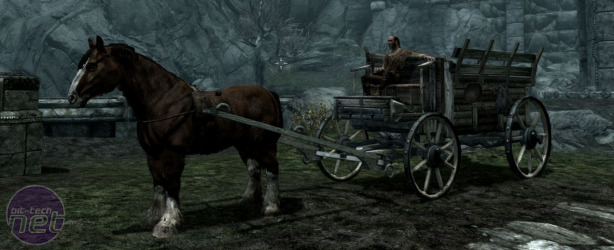
Elder Scrolls V: Skyrim Combat and Conclusion
When we did re-join the main plot, we really got caught up in it. We were quickly gifted with a housecarl (a servant who’s also handy in a fight) called Lydia who could not only carry a prodigious amount of loot (some of which she’ll equip, but not keep), but also help fend off those pesky frost trolls. Lydia seemed unable to die unless we accidentally hit her while she’s low on health, something that only happened once, and we reloaded anyway, so she’s none the wiser.When humanoid characters are low on health they crawl on all fours, begging for mercy, or just kneel before you. We ending up shooting a lot of enemies in the bottom as they crawled away; it amused us. Lydia showed no quarter either, once sending four feet of iron arrow through a bandit’s eye as he pleaded for his life on his knees in front of her. You can also hire mercenaries, should you need or want to.

Our kleptomaniac tendencies and the fact that clothing usually has a high
gold-to-weight ratio left a lot of bodies like this. Disrespectful much?
Combat in Skyrim is often as unwieldy as it is in Oblivion, though. Despite being a master in two-handed weaponry - more as a result of our desire to cause maximum damage to draugr (undead) and later frost trolls than any considered plan – we were still flailing around like amateurs. However, when we did make contact, we were greeted with sprays and gouts of blood. To really ramp up the violence level, there’s a bunch of finishing moves that cut in when you strike a particularly hard killing blow. One example that sticks in the mind was our propensity to slice off a leg at the knee and then cleave the skull like a woodcutter as the enemy toppled forward.
Combat might not be elegant, but it’s fun and functional. There’s also a new way to fast-travel to the corners of the far-flung map to alleviate the boredom of running or riding around. Pay a carriage man 20 Gold, and he’ll take you to any major town. Once you’ve discovered some locations there (typically the stables), you can fast-travel there for free from then on.
The carriages are a neat way to sum up Skyrim: the game is so huge that you need private transport to get around, but unlike previous Elder Scrolls games, it removes any tedious consequences. The new menus for inventory and powers are elegant and quick, the favourites system is excellent and the way that characters now wield spells in their hands makes them fun to use. There are few areas, apart from those inhabited by frost trolls, where we genuinely felt the game had let us down by making us do stupid rule-bending. Whenever we felt it had, it was usually our fault for not finding a lever to pull or button to push.
The main baddies – the dragons – are so much more spectacular and fun to fight than the daedra in Oblivion Gates too. There’s no drudging through towers, getting lost and backtracking. You just see a dragon on your radar bar or map, go there and fight the dragon. These showdowns are also just as impressive and exciting as they should be, despite their suicidal landing tactics.
Even the parts that shouldn’t make sense in Skyrim aren’t worth worrying about: those well-tended braziers in abandoned caves, for example. It’s like watching Star Wars and genuinely thinking, ‘what about those poor Death Star construction workers?’ You’re missing the point: Skyrim is a huge and engaging world to explore and it treats you with great moments, from your first dragon encounter to finally being able to craft dwarven armour.

-
Overall95 / 100


MSI MPG Velox 100R Chassis Review
October 14 2021 | 15:04










Want to comment? Please log in.